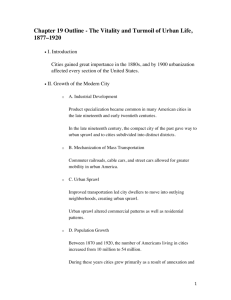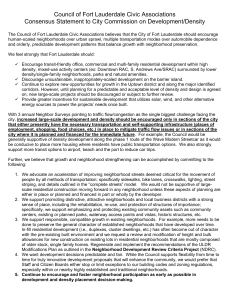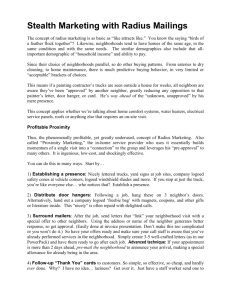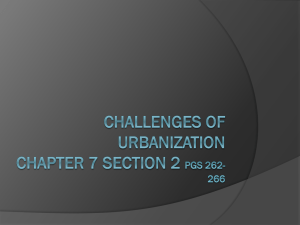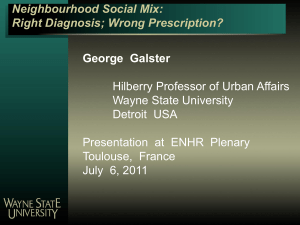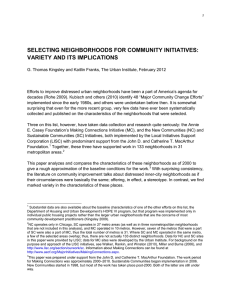Summary of Current Research in Social Equity Mapping and Data
advertisement
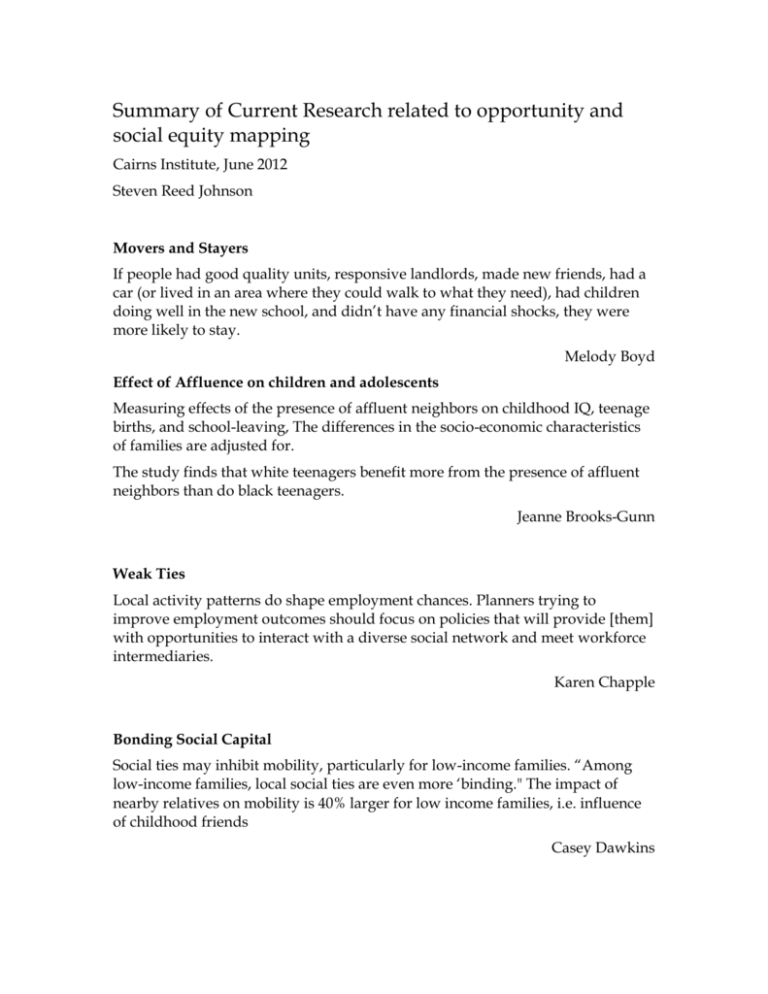
Summary of Current Research related to opportunity and social equity mapping Cairns Institute, June 2012 Steven Reed Johnson Movers and Stayers If people had good quality units, responsive landlords, made new friends, had a car (or lived in an area where they could walk to what they need), had children doing well in the new school, and didn’t have any financial shocks, they were more likely to stay. Melody Boyd Effect of Affluence on children and adolescents Measuring effects of the presence of affluent neighbors on childhood IQ, teenage births, and school-leaving, The differences in the socio-economic characteristics of families are adjusted for. The study finds that white teenagers benefit more from the presence of affluent neighbors than do black teenagers. Jeanne Brooks-Gunn Weak Ties Local activity patterns do shape employment chances. Planners trying to improve employment outcomes should focus on policies that will provide [them] with opportunities to interact with a diverse social network and meet workforce intermediaries. Karen Chapple Bonding Social Capital Social ties may inhibit mobility, particularly for low-income families. “Among low-income families, local social ties are even more ‘binding." The impact of nearby relatives on mobility is 40% larger for low income families, i.e. influence of childhood friends Casey Dawkins Methods of evaluating local influences on social opportunities 1) Neighborhood resources (reputation; services; job accessibility; recreation; health; etc.) (2) Model learning via social ties and interrelationships (interpersonal networks and peer groups) (3) Socialization and collective efficacy (norms, control of public space) (4) Resident perceptions of deviance (crime, drug dealing; physical decay and disorder) Jurgen Friedrichs Neighborhood impact on Immigrants socioeconomic advancement various aspects of neighborhood context independently affect the ability of immigrants to advance economically in several dimensions.” “support the notion that neighborhoods isolated from the world of work and characterized by minimal educational achievement impose multifaceted, deleterious economic impacts on immigrants, just as they do for native-born residents” George Galster Immigrants fare better than existent ethnic populations (e.g., blacks, Hispanic) White immigrants are generally as residentially assimilated as whites as a whole many nonwhite immigrant groups have diverse interracial and interethnic exposure, but this is rarely the case for white immigrants, who typically follow the same segregated living patterns established by whites. In general It is not the case that immigrants are being left behind in the urban core and are exposed to the sort of disadvantageous neighborhood conditions to which black households are exposed (p.431- 433, all verbatim). George Galster Neighborhood impacts on Youth development Much statistical evidence supports the influence of neighborhood social networks and economic conditions on youth’s intellectual development, educational attainment, marriage and fertility, labor market participation and earnings, and, to a lesser extent, criminal behavior and drug use. George Galster Indicators of conditions confronting Youth Found that the variables vary spatially, and that extreme values of the indicators tend to cluster in particular geographic areas. Also looked at how indicators of disadvantage correlate with each other. Most of them are highly correlated, but tract poverty rates are not good predictors of all types of disadvantage; for example, poverty rates don’t predict drug, property, or violent crimes; therefore, neighborhood poverty rates are imperfect proxy for the robust opportunity nexus. George Galster Rise in Poverty in inner suburbs The stunning progress is the decline of the number of people living in concentrated poverty, and the number of concentrated poverty neighborhoods, but the hidden problem is the rise in poverty in the older / inner-ring suburbs. Paul Jargowsky Postal Codes and Obesity Each additional $100,000 in median home value for a ZIP code corresponded with a drop in obesity of 2% points. This beat income and education as predictors. Hypothesized reasons: in less affluent areas, lack of access to fresh produce, health insurance, and affordable, nutritious groceries. Jennifer Langston Mental Health and MTO Parents who moved to low-poverty neighborhoods reported significantly less distress than parents who remained in high-poverty neighborhoods. Boys who moved to less poor neighborhoods reported significantly fewer anxious/depressive and dependency problems than boys who stayed in public housing.” Tama Leventhal

